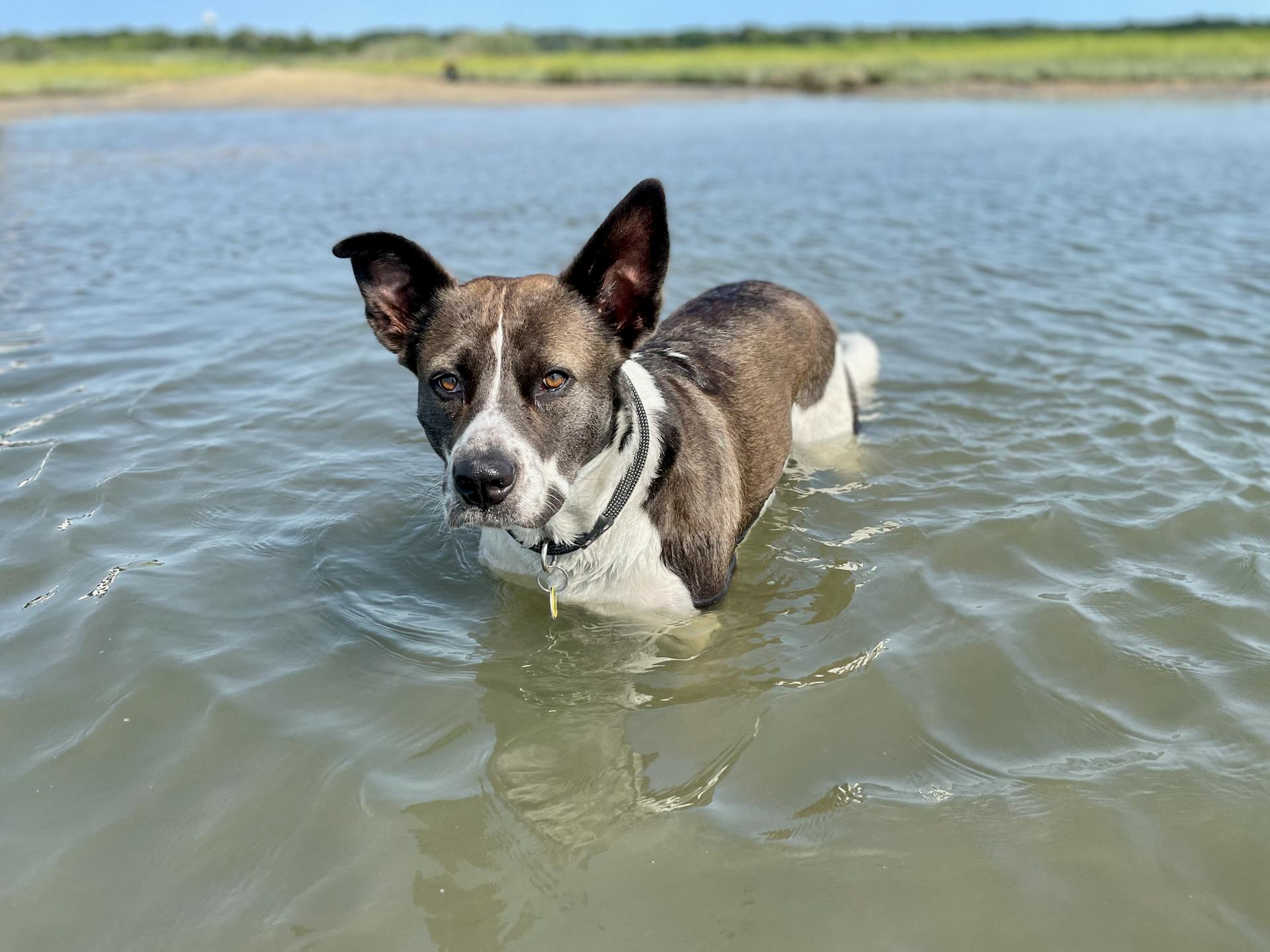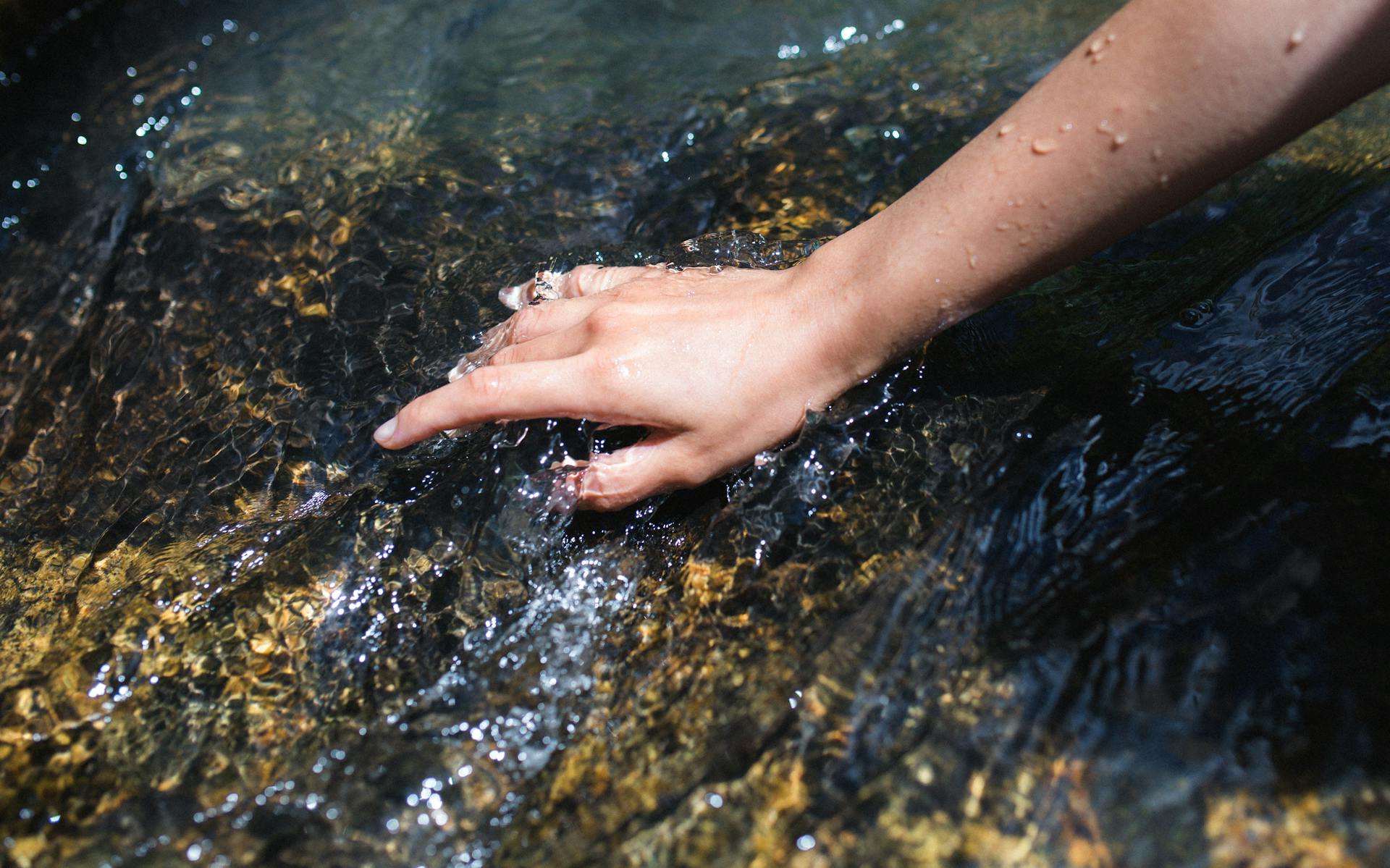
Canine hydrotherapy is a game-changer for dogs with mobility issues or injuries. It's a low-impact, non-invasive way to promote healing and rehabilitation.
Water therapy pools are specifically designed for dogs, with temperatures ranging from 80 to 90 degrees Fahrenheit. This warm water reduces muscle spasms and increases blood flow to the affected areas.
Studies have shown that canine hydrotherapy can reduce pain and inflammation by up to 50%. It's a safe and effective way to get your dog moving again.
With the right equipment and trained professionals, canine hydrotherapy can be tailored to meet the specific needs of your dog.
For another approach, see: Portuguese Water Dog Health Problems
What Is Canine Hydrotherapy?
Canine hydrotherapy is a type of therapy that uses water to help dogs recover from injuries and manage pain. It's especially beneficial for dogs with conditions like arthritis, hip dysplasia, and torn ACLs.
Hydrotherapy uses the properties of water, such as buoyancy and resistance, to provide weightless physical therapy. This reduces the stress on a dog's joints as they try to recover from an injury.
Explore further: Water Therapy for Dogs
The buoyancy of water makes it easier for dogs to move their joints without putting too much strain on them. This is especially helpful for dogs with joint problems.
Hydrotherapy can also be used to relieve pain and reduce swelling in body tissues. It's a natural anti-inflammatory that can help dogs feel more comfortable.
Dogs with conditions like cruciate ligament damage, obesity, and post-operative rehabilitation can also benefit from hydrotherapy. It can help improve their mobility, strength, balance, and coordination.
Hydrotherapy is a great way to help dogs recover from injuries and manage pain. It's a natural and effective way to improve their overall health and fitness.
Benefits and Uses
Canine hydrotherapy is a game-changer for dogs with injuries or painful conditions. It can speed up recovery after operations or slow the progression of degenerative conditions.
As an alternative or complement to weight-bearing exercise and medication, hydrotherapy can be used to maintain a dog's condition before surgery or to alleviate pain and stiffness associated with arthritis and joint issues.
Exercising in water provides support and allows dogs to exercise their muscles without putting excessive weight on their joints. This is especially beneficial for dogs with spinal injuries or surgery, as it allows them to exercise while nerve regeneration takes place.
Hydrotherapy can also help dogs build fitness and lose weight without putting excessive strain on their joints. It's a low-impact exercise option that's perfect for overweight and obese dogs.
Here are some of the key benefits of hydrotherapy for dogs:
• Increased mobility and flexibility
• Pain relief and relaxation
• Weight management
• Mental stimulation and emotional well-being
• Enhanced recovery and rehabilitation
By incorporating hydrotherapy into their routine, dogs can experience improved range of motion, muscle flexibility, and overall mobility. They can also alleviate muscle spasms, promote blood circulation, and even heal tissue.
Types of Hydrotherapy
Canine hydrotherapy is a fantastic way to help your furry friend recover from injuries or surgery, or even just to get some exercise and fun. There are several types of hydrotherapy that can be used for dogs.
Swimming is one of the most common forms of hydrotherapy, and it's a great way to get your dog moving without putting too much stress on their joints. A hydrotherapy treadmill is another option, allowing your dog to walk or run on a moving belt of water while reducing the impact on their joints.
Underwater treadmills are the most common form of hydrotherapy for dogs, particularly those with joint issues and arthritis. These treadmills are encased in a glass or plastic chamber and provide a low-impact exercise that strengthens joint muscles without the stress of gravity.
Here are some of the most common types of hydrotherapy for dogs:
Pool Design
Pool design is a crucial aspect of hydrotherapy, and it varies depending on the type of animal being treated.
Most canine hydrotherapy pools are smaller than human swimming pools and are heated to help the dog's muscles benefit from the warming effects of the water.
A ramp for entry and exit is a common feature in these pools, making it easier for dogs to get in and out of the water.
Some pools have harnesses to keep the dog in position in the water, while others use a manual or electric hoist to lift the dog in and out of the water.
Water is typically chlorinated or treated with an alternative chemical to ensure cleanliness.
Dog Pools
Dog Pools are a type of hydrotherapy that provide resistance to help improve joint mobility and reduce pain in dogs with arthritis or degenerative joint issues.
Most Dog Pools are designed to target specific areas of the body, such as elbows, chest muscles, limbs, and shoulders. The size and depth of the pool will depend on the therapist or vet and the specific needs of your dog.
Your dog will typically wear a floater or harness while in the pool, and a therapist will be present to monitor their movements and provide assistance if needed.
Some Dog Pools have features such as ramps for entry and exit, and manual or electric hoists for lifting dogs in and out of the water. The water is usually chlorinated or treated with an alternative chemical to ensure it's safe and clean for your dog to swim in.
Here are some benefits of Dog Pools:
- Improve joint mobility and reduce pain in dogs with arthritis or degenerative joint issues
- Provide resistance to help strengthen joint muscles
- Can be tailored to target specific areas of the body
- Typically include a therapist to monitor and assist your dog
- May have features such as ramps and hoists for easy entry and exit
Principles and Properties
Canine hydrotherapy is built on a strong foundation of principles and properties that make it an effective treatment for dogs. The buoyancy of water helps support the weight of the dog, reducing stress on joints and muscles.
The natural resistance offered by water stimulates muscular development and strength without putting undue stress on the joints and tendons. This resistance is also used to strengthen muscles and improve fitness.
Water's viscosity provides additional support for unstable joints, making it easier for dogs to move through water than on land. The viscosity of water also makes it more difficult for the animal to move through water, which is used to strengthen muscles.
History

Hydrotherapy for humans has been used since ancient times, and some attempt at formalizing treatment was made during the 18th century. This ancient practice laid the groundwork for the development of hydrotherapy for animals.
The benefits of seawater for treating leg injuries in horses have been known for centuries. It's amazing to think that something that's been around for so long is still effective today.
The greyhound racing industry eventually recognized the benefits of this treatment and brought it to the forefront in the UK with a specialized canine hydrotherapy pool. This was a key moment in the history of hydrotherapy for dogs.
In the mid-19th century, inventors began producing devices to replicate the benefits of cold seawater immersion for horses, driven by the financial benefits of treating racehorses. These early innovations paved the way for the development of modern hydrotherapy equipment.
See what others are reading: Canine Cancer Treatment
Properties of Water
Water's relative density is lower than that of most substances, making it easier for dogs to move around in. This property, combined with buoyancy, allows dogs to exercise while minimizing stress on their joints and muscles.
The viscosity of water provides resistance to movement, making it more difficult for dogs to move through water than through air. This resistance is used to strengthen muscles and improve fitness.
Buoyancy is the upward thrust of water acting on a body, creating an apparent decrease in weight while immersed. This principle is essential for canine hydrotherapy, as it allows dogs to exercise while minimizing weight-bearing on sore joints.
Water's hydrostatic pressure is constant and exerted on all parts of a dog's body when immersed. This pressure reduces edema, provides stimulation to skin afferent sensory receptors, and decreases pain perception, making it an ideal environment for treating swollen joints or limbs.
The surface tension of water is another important property that affects canine hydrotherapy. However, this property is not explicitly mentioned in the article sections provided.
Here's an interesting read: My Dog Has a Terrible Odor
Frequently Asked Questions
How much does dog hydrotherapy cost?
On average, a dog hydrotherapy session costs around £36.28 in the UK, with prices starting from £30 at many centres.
How often should a dog do hydrotherapy?
Hydrotherapy frequency varies based on your dog's fitness level and condition, typically starting at twice a week and adjusting to once a week or less as they progress. Regular sessions can be tailored to meet your dog's unique needs.
Can you do hydrotherapy for your dog at home?
Yes, dog hydrotherapy can be done at home, offering numerous benefits for your pet's health and well-being. Learn how to enhance your dog's health with this effective and enjoyable therapy.
Sources
- https://en.wikipedia.org/wiki/Canine_hydrotherapy
- https://bentonville.earthwisepet.com/content/other/Canine-Hydrotherapy-A-Complete-Guide-to-the-Benefits-and-Process/
- https://dogtime.com/dog-health/82775-hydrotherapy-for-dogs
- https://mycanineaquaticcenter.com/how-does-hydrotherapy-for-dogs-work/
- https://ivcjournal.com/hydrotherapy-canine-physical-rehab/
Featured Images: pexels.com


